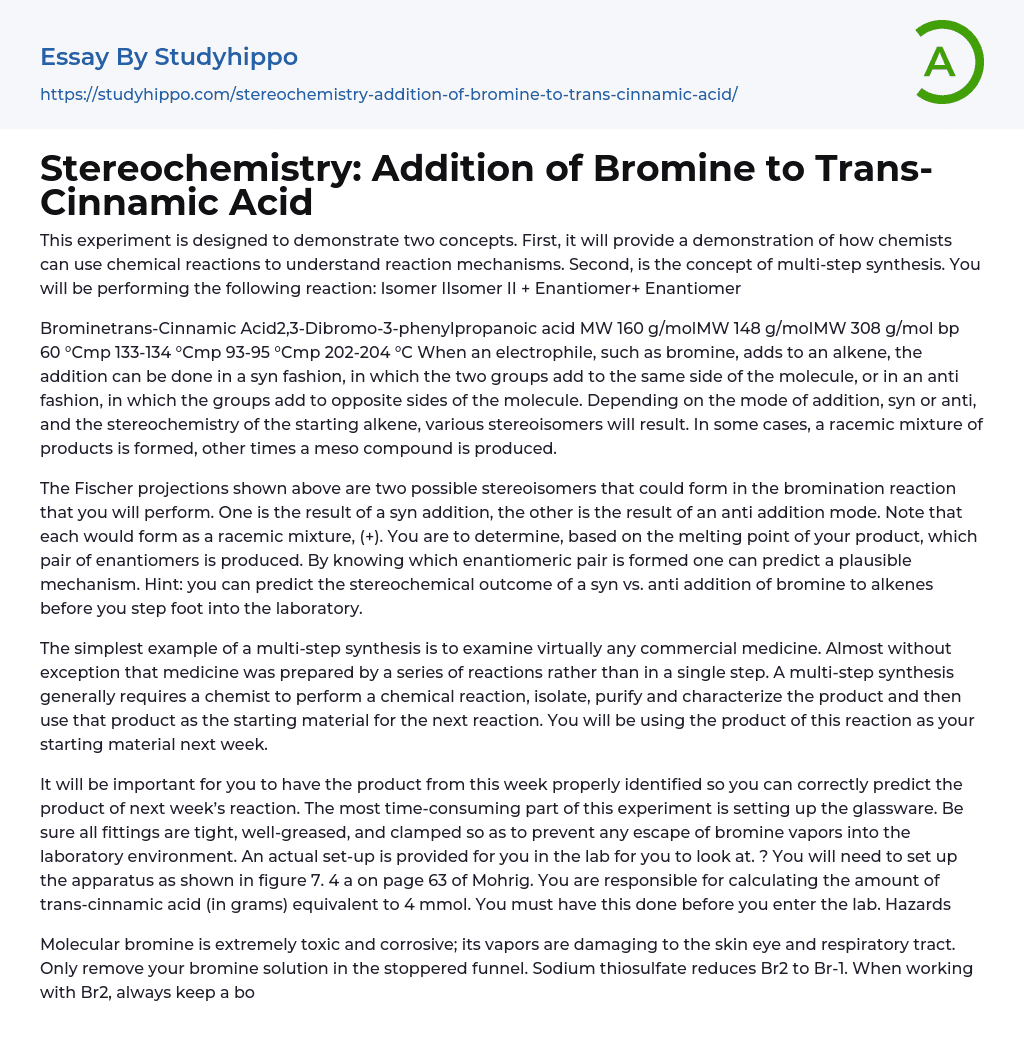

Stereochemistry: Addition of Bromine to Trans-Cinnamic Acid Essay Example
This experiment is designed to demonstrate two concepts. First, it will provide a demonstration of how chemists can use chemical reactions to understand reaction mechanisms. Second, is the concept of multi-step synthesis. You will be performing the following reaction: Isomer IIsomer II + Enantiomer+ Enantiomer
Brominetrans-Cinnamic Acid2,3-Dibromo-3-phenylpropanoic acid MW 160 g/molMW 148 g/molMW 308 g/mol bp 60 °Cmp 133-134 °Cmp 93-95 °Cmp 202-204 °C When an electrophile, such as bromine, adds to an alkene, the addition can be done in a syn fashion, in which the two groups add to the same side of the molecule, or in an anti fashion, in which the groups add to opposite sides of the molecule. Depending on the mode of addition, syn or anti, and the stereochemistry of the starting alkene, various stereoisomers will result. In some cases, a race
...mic mixture of products is formed, other times a meso compound is produced.
The Fischer projections shown above are two possible stereoisomers that could form in the bromination reaction that you will perform. One is the result of a syn addition, the other is the result of an anti addition mode. Note that each would form as a racemic mixture, (+). You are to determine, based on the melting point of your product, which pair of enantiomers is produced. By knowing which enantiomeric pair is formed one can predict a plausible mechanism. Hint: you can predict the stereochemical outcome of a syn vs. anti addition of bromine to alkenes before you step foot into the laboratory.
The simplest example of a multi-step synthesis is to examine virtually any commercial medicine. Almost without exception that medicine wa
prepared by a series of reactions rather than in a single step. A multi-step synthesis generally requires a chemist to perform a chemical reaction, isolate, purify and characterize the product and then use that product as the starting material for the next reaction. You will be using the product of this reaction as your starting material next week.
It will be important for you to have the product from this week properly identified so you can correctly predict the product of next week’s reaction. The most time-consuming part of this experiment is setting up the glassware. Be sure all fittings are tight, well-greased, and clamped so as to prevent any escape of bromine vapors into the laboratory environment. An actual set-up is provided for you in the lab for you to look at. ? You will need to set up the apparatus as shown in figure 7. 4 a on page 63 of Mohrig. You are responsible for calculating the amount of trans-cinnamic acid (in grams) equivalent to 4 mmol. You must have this done before you enter the lab. Hazards
Molecular bromine is extremely toxic and corrosive; its vapors are damaging to the skin eye and respiratory tract. Only remove your bromine solution in the stoppered funnel. Sodium thiosulfate reduces Br2 to Br-1. When working with Br2, always keep a bottle of 5% sodium thiosulfate handy for rinsing the skin in case of contact. Experimental ? Assemble a 50 mL round-bottom flask with a Claisen head, reflux condenser, and addition funnel. Into the round-bottom flask, add trans-cinnamic acid (4 mmol) and 10 mL of methylene chloride.
Add a stir bar. Obtain
4. 0 mL of a 1. 0 M solution of bromine in methylene chloride in the addition funnel. Attach a heating mantle and variac and heat the mixture to a gentle reflux. The variac setting should initially be 25-30. Adjust this setting as necessary until the solution is refluxing . While it is refluxing, add the bromine solution at a rate of two drops per second. You need not loosen the stopper on the funnel for the bromine addition due to the high density of methylene chloride. The red-orange color of the bromine should dissipate as it reacts with the mixture.
Continue to reflux for an additional 10 minutes after the last of the bromine has been added. ? The color of your final solution should be a very pale yellow. If the red-orange color persists after the 10 min, add cyclohexene dropwise (1-2 mL) until the red color disappears. Remove the reaction flask and cool it in an ice bath for 10 minutes with a greased stopper on top. Allow the product, 2,3-dibromo-3-phenylpropanoic acid, to crystallize. Meanwhile, disassemble the rest of the reflux apparatus and sit it in the back of your hood to allow the fumes to dissipate.
Rinse the glassware with a small amount of sodium thiosulfate to destroy any remaining bromine. ? Collect the crystalline product by suction-filtration, and rinse with a minimal amount of ice-cold methylene chloride. Allow it to air-dry and record the mass and melting range of the product. Have your instructor check the weight of your product and initial this value in your lab notebook. Save all of your product as it is the starting
material for next week. Use perspective drawings, Fischer Projections and words, to demonstrate whether syn addition of bromine to trans-cinnamic acid results in Isomer I or Isomer II. Repeat the process for anti addition.
- Distillation essays
- Amylase essays
- Magnesium essays
- Acid essays
- Calcium essays
- Carbohydrate essays
- Carbon essays
- Chemical Bond essays
- Chemical Reaction essays
- Chemical reactions essays
- Chromatography essays
- Concentration essays
- Copper essays
- Diffusion essays
- Ethanol essays
- Hydrogen essays
- Organic Chemistry essays
- Osmosis essays
- Periodic Table essays
- Ph essays
- Salt essays
- Sodium essays
- Titration essays



